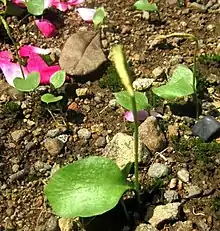Ophioglossum reticulatum
Ophioglossum reticulatum, the netted adder's-tongue, is a species of fern in the family Ophioglossaceae.[3] It has a pantropical/pansubtropical distribution; Latin America, the Caribbean, Sub-Saharan Africa, Madagascar, Yemen, the Indian Subcontinent, Southeast Asia, warmer parts of China, Malesia, Korea, Japan, and many tropical islands.[2] A hexaploid, it has the highest number of chromosomes of any plant, 720.[4] Its leaves—or leaf, individuals only grow one per year—are edible, and are regularly consumed by people in Africa and Asia.[5][6]
| Ophioglossum reticulatum | |
|---|---|
 | |
| Habit | |
.jpg.webp) | |
| Botanical illustration | |
| Scientific classification | |
| Kingdom: | Plantae |
| Clade: | Tracheophytes |
| Division: | Polypodiophyta |
| Class: | Polypodiopsida |
| Order: | Ophioglossales |
| Family: | Ophioglossaceae |
| Genus: | Ophioglossum |
| Species: | O. reticulatum |
| Binomial name | |
| Ophioglossum reticulatum | |
| Synonyms[2] | |
|
List
| |
References
- Irudayaraj, V. (2011). "Ophioglossum reticulatum". IUCN Red List of Threatened Species. 2011: e.T194160A8885705. doi:10.2305/IUCN.UK.2011-1.RLTS.T194160A8885705.en. Retrieved 28 November 2022.
- "Ophioglossum reticulatum L." Plants of the World Online. Royal Botanic Gardens, Kew. Retrieved 2 September 2022.
- Schoch, C. L.; Ciufo, S.; Domrachev, M.; Hotton, C. L.; Kannan, S.; Khovanskaya, R.; Leipe, D.; McVeigh, R.; O'Neill, K.; Robbertse, B.; Sharma, S.; Soussov, V.; Sullivan, J. P.; Sun, L.; Turner, S.; Karsch-Mizrachi, I. (2020). "NCBI Taxonomy: A comprehensive update on curation, resources and tools". Database: The Journal of Biological Databases and Curation. 2020: baaa062. doi:10.1093/database/baaa062. PMC 7408187. PMID 32761142.
- Lukhtanov, Vladimir (2015). "The blue butterfly Polyommatus (Plebicula) atlanticus (Lepidoptera, Lycaenidae) holds the record of the highest number of chromosomes in the non-polyploid eukaryotic organisms". Comparative Cytogenetics. 9 (4): 683–690. doi:10.3897/CompCytogen.v9i4.5760. PMC 4698580. PMID 26753083.
- Maroyi, Alfred (2014). "Not just minor wild edible forest products: Consumption of pteridophytes in sub-Saharan Africa". Journal of Ethnobiology and Ethnomedicine. 10: 78. doi:10.1186/1746-4269-10-78. PMC 4290087. PMID 25534561.
- Ojha, Rijan; Devkota, Hari Prasad (2021). "Edible and Medicinal Pteridophytes of Nepal: A Review". Ethnobotany Research and Applications. 22. doi:10.32859/era.22.16.1-16. S2CID 239709292.
This article is issued from Wikipedia. The text is licensed under Creative Commons - Attribution - Sharealike. Additional terms may apply for the media files.
